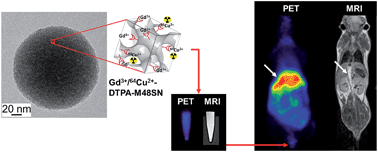Metal chelate grafting at the surface of mesoporous silica nanoparticles (MSNs): physico-chemical and biomedical imaging assessment†
Abstract
Mesoporous silica nanoparticles (MSNs) are being developed as drug delivery vectors. Biomedical imaging (MRI and PET) enables their tracking in vivo, provided their surface is adequately grafted with imaging probes (metal chelates). However, MSNs are characterized by huge specific surfaces, and high-quality metal chelate anchoring procedures must be developed and validated, to demonstrate that their detection in vivo is associated to the presence of nanoparticles and not to detached metal chelates. MCM-48 nanospheres (M48SNs, 150 nm diam., 3-D pore geometry) were synthesized and functionalized with diethylenetriaminepentaacetic acid (DTPA). The strong grafting of DTPA was confirmed by 29Si MAS-NMR, XPS, FTIR and TGA. The particles were labeled with paramagnetic ions Gd3+ (for MRI) as well as radioactive ions 64Cu2+ (for PET; half-life: 12.7 h). Gd3+-DTPA-M48SNs formed a stable colloid in saline media for at least 6 months, without any sign of aggregation. The relaxometric properties were measured at various magnetic fields. The strength of DTPA binding at the surface of MSNs was also assessed in vivo, by injecting mice (i.v.) with Gd3+/64Cu2+-DTPA-M48SNs. Vascular retention and urinary clearance were monitored by MRI, whereas the PET modality provided dynamic and quantitative assessment of biodistribution and blood/organ clearance. No significant 64Cu activity was detectable in the bladder. The study confirmed the very limited detachment of DTPA from M48SNs cores once injected in vivo. The transit of MSNs through the liver and intestinal tract, does not lead to evidence of Gd3+/64Cu2+-DTPA in the urine. This physico-chemical and biodistribution study confirms the quality of DTPA attachment at the surface of the particles, necessary to allow further development of PET/MRI-assisted MSN-vectorized drug delivery procedures.

- This article is part of the themed collection: 2015 Journal of Materials Chemistry B Hot Papers

 Please wait while we load your content...
Please wait while we load your content...